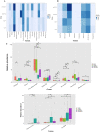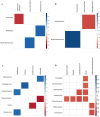Gut microbiota composition in health-care facility-and community-onset diarrheic patients with Clostridioides difficile infection
- PMID: 34035404
- PMCID: PMC8149855
- DOI: 10.1038/s41598-021-90380-7
Gut microbiota composition in health-care facility-and community-onset diarrheic patients with Clostridioides difficile infection
Abstract
The role of gut microbiota in the establishment and development of Clostridioides difficile infection (CDI) has been widely discussed. Studies showed the impact of CDI on bacterial communities and the importance of some genera and species in recovering from and preventing infection. However, most studies have overlooked important components of the intestinal ecosystem, such as eukaryotes and archaea. We investigated the bacterial, archaea, and eukaryotic intestinal microbiota of patients with health-care-facility- or community-onset (HCFO and CO, respectively) diarrhea who were positive or negative for CDI. The CDI-positive groups (CO/+, HCFO/+) showed an increase in microorganisms belonging to Bacteroidetes, Firmicutes, Proteobacteria, Ascomycota, and Opalinata compared with the CDI-negative groups (CO/-, HCFO/-). Patients with intrahospital-acquired diarrhea (HCFO/+, HCFO/-) showed a marked decrease in bacteria beneficial to the intestine, and there was evidence of increased Archaea and Candida and Malassezia species compared with the CO groups (CO/+, CO/-). Characteristic microbiota biomarkers were established for each group. Finally, correlations between bacteria and eukaryotes indicated interactions among the different kingdoms making up the intestinal ecosystem. We showed the impact of CDI on microbiota and how it varies with where the infection is acquired, being intrahospital-acquired diarrhea one of the most influential factors in the modulation of bacterial, archaea, and eukaryotic populations. We also highlight interactions between the different kingdoms of the intestinal ecosystem, which need to be evaluated to improve our understanding of CDI pathophysiology.
Conflict of interest statement
The authors declare no competing interests.
Figures




Similar articles
-
Updating changes in human gut microbial communities associated with Clostridioides difficile infection.Gut Microbes. 2021 Jan-Dec;13(1):1966277. doi: 10.1080/19490976.2021.1966277. Gut Microbes. 2021. PMID: 34486488 Free PMC article. Review.
-
Microbial Interdomain Interactions Delineate the Disruptive Intestinal Homeostasis in Clostridioides difficile Infection.Microbiol Spectr. 2022 Oct 26;10(5):e0050222. doi: 10.1128/spectrum.00502-22. Epub 2022 Sep 26. Microbiol Spectr. 2022. PMID: 36154277 Free PMC article.
-
Response of the gut microbiota during the Clostridioides difficile infection in tree shrews mimics those in humans.BMC Microbiol. 2020 Aug 20;20(1):260. doi: 10.1186/s12866-020-01943-z. BMC Microbiol. 2020. PMID: 32819295 Free PMC article.
-
Analysis of Intestinal Mycobiota of Patients with Clostridioides difficile Infection among a Prospective Inpatient Cohort.Microbiol Spectr. 2022 Aug 31;10(4):e0136222. doi: 10.1128/spectrum.01362-22. Epub 2022 Jul 14. Microbiol Spectr. 2022. PMID: 35867408 Free PMC article.
-
Microbe-microbe interactions during Clostridioides difficile infection.Curr Opin Microbiol. 2020 Feb;53:19-25. doi: 10.1016/j.mib.2020.01.016. Epub 2020 Feb 20. Curr Opin Microbiol. 2020. PMID: 32088581 Free PMC article. Review.
Cited by
-
Symbiotic biofilms formed by Clostridioides difficile and bacteroides thetaiotaomicron in the presence of vancomycin.Gut Microbes. 2024 Jan-Dec;16(1):2390133. doi: 10.1080/19490976.2024.2390133. Epub 2024 Aug 12. Gut Microbes. 2024. PMID: 39132815 Free PMC article.
-
Parasitism-Induced Changes in Microbial Eukaryotes of Peruvian Alpaca Gastrointestinal Tract.Life (Basel). 2024 Jan 27;14(2):187. doi: 10.3390/life14020187. Life (Basel). 2024. PMID: 38398696 Free PMC article.
-
A Comparison of Currently Available and Investigational Fecal Microbiota Transplant Products for Recurrent Clostridioides difficile Infection.Antibiotics (Basel). 2024 May 12;13(5):436. doi: 10.3390/antibiotics13050436. Antibiotics (Basel). 2024. PMID: 38786164 Free PMC article. Review.
-
Updating changes in human gut microbial communities associated with Clostridioides difficile infection.Gut Microbes. 2021 Jan-Dec;13(1):1966277. doi: 10.1080/19490976.2021.1966277. Gut Microbes. 2021. PMID: 34486488 Free PMC article. Review.
-
Microbial Interdomain Interactions Delineate the Disruptive Intestinal Homeostasis in Clostridioides difficile Infection.Microbiol Spectr. 2022 Oct 26;10(5):e0050222. doi: 10.1128/spectrum.00502-22. Epub 2022 Sep 26. Microbiol Spectr. 2022. PMID: 36154277 Free PMC article.
References
Publication types
MeSH terms
Substances
LinkOut - more resources
Full Text Sources
Other Literature Sources
Medical

